YAMAHA XV535 2001 Manual PDF
Manufacturer: YAMAHA, Model Year: 2001, Model line: XV535, Model: YAMAHA XV535 2001Pages: 96, PDF Size: 10.38 MB
Page 71 of 96
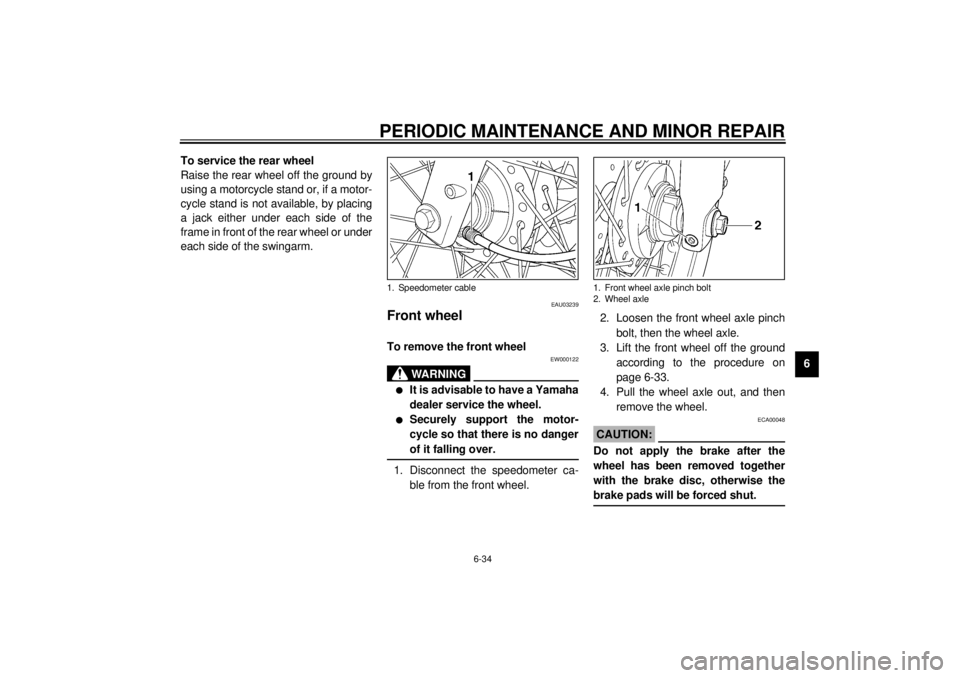
PERIODIC MAINTENANCE AND MINOR REPAIR
6-34
6 To service the rear wheel
Raise the rear wheel off the ground by
using a motorcycle stand or, if a motor-
cycle stand is not available, by placing
a jack either under each side of the
frame in front of the rear wheel or under
each side of the swingarm.
EAU03239
Front wheel To remove the front wheel
EW000122
WARNING
_ l
It is advisable to have a Yamaha
dealer service the wheel.
l
Securely support the motor-
cycle so that there is no danger
of it falling over.
_1. Disconnect the speedometer ca-
ble from the front wheel.2. Loosen the front wheel axle pinch
bolt, then the wheel axle.
3. Lift the front wheel off the ground
according to the procedure on
page 6-33.
4. Pull the wheel axle out, and then
remove the wheel.
ECA00048
CAUTION:_ Do not apply the brake after the
wheel has been removed together
with the brake disc, otherwise the
brake pads will be forced shut. _
1. Speedometer cable
1. Front wheel axle pinch bolt
2. Wheel axle
E_3bt.book Page 34 Thursday, September 7, 2000 10:01 AM
Page 72 of 96
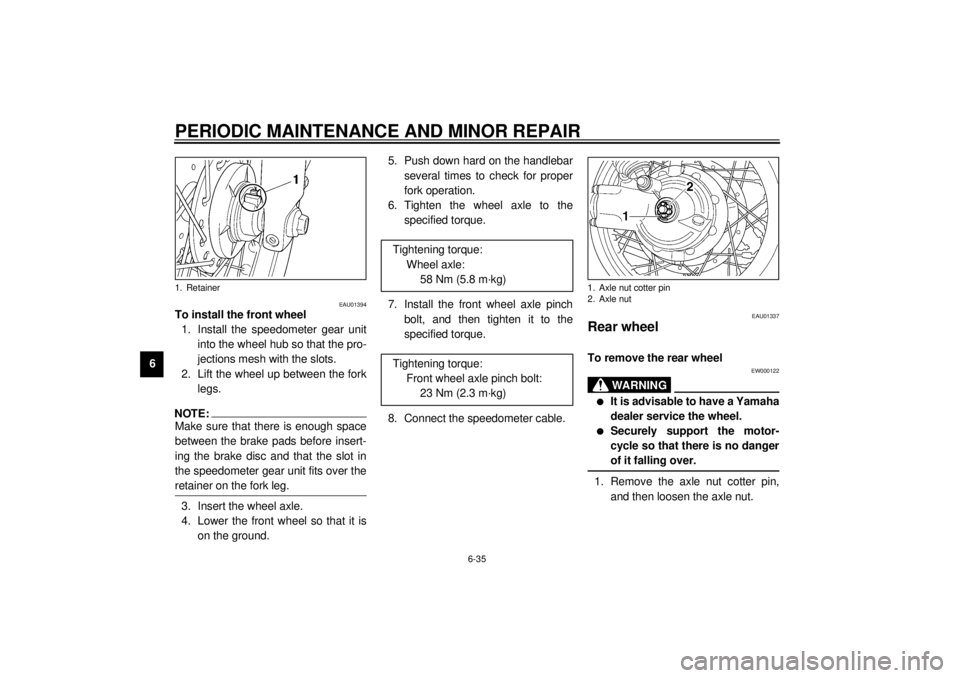
PERIODIC MAINTENANCE AND MINOR REPAIR
6-35
6
EAU01394
To install the front wheel
1. Install the speedometer gear unit
into the wheel hub so that the pro-
jections mesh with the slots.
2. Lift the wheel up between the fork
legs.NOTE:_ Make sure that there is enough space
between the brake pads before insert-
ing the brake disc and that the slot in
the speedometer gear unit fits over the
retainer on the fork leg. _3. Insert the wheel axle.
4. Lower the front wheel so that it is
on the ground.5. Push down hard on the handlebar
several times to check for proper
fork operation.
6. Tighten the wheel axle to the
specified torque.
7. Install the front wheel axle pinch
bolt, and then tighten it to the
specified torque.
8. Connect the speedometer cable.
EAU01337
Rear wheel To remove the rear wheel
EW000122
WARNING
_ l
It is advisable to have a Yamaha
dealer service the wheel.
l
Securely support the motor-
cycle so that there is no danger
of it falling over.
_1. Remove the axle nut cotter pin,
and then loosen the axle nut.
1. Retainer
Tightening torque:
Wheel axle:
58 Nm (5.8 m·kg)
Tightening torque:
Front wheel axle pinch bolt:
23 Nm (2.3 m·kg)
1. Axle nut cotter pin
2. Axle nut
E_3bt.book Page 35 Thursday, September 7, 2000 10:01 AM
Page 73 of 96
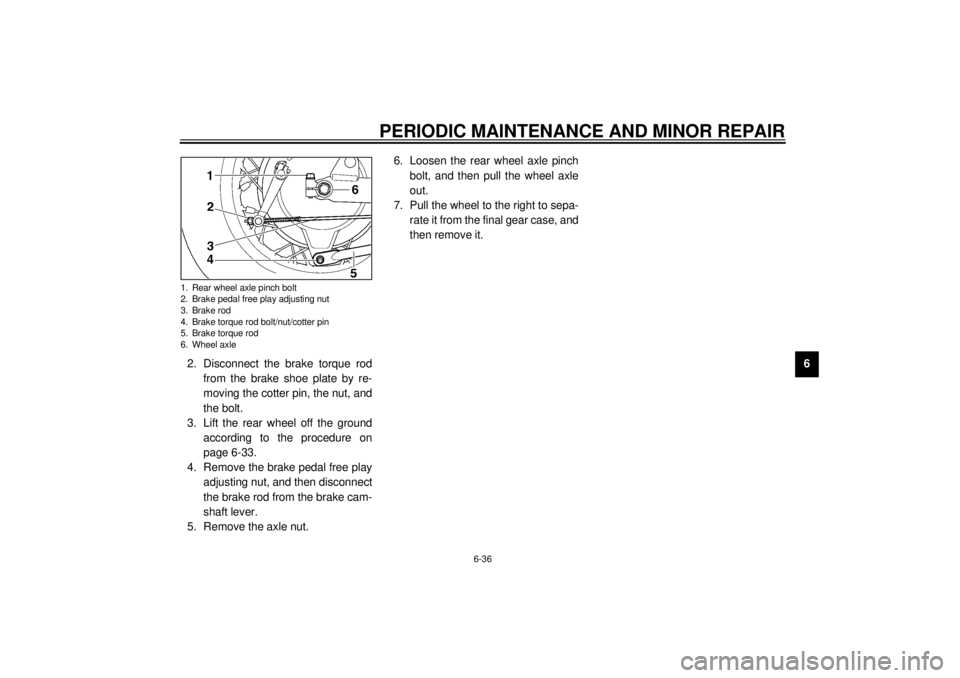
PERIODIC MAINTENANCE AND MINOR REPAIR
6-36
6
2. Disconnect the brake torque rod
from the brake shoe plate by re-
moving the cotter pin, the nut, and
the bolt.
3. Lift the rear wheel off the ground
according to the procedure on
page 6-33.
4. Remove the brake pedal free play
adjusting nut, and then disconnect
the brake rod from the brake cam-
shaft lever.
5. Remove the axle nut.6. Loosen the rear wheel axle pinch
bolt, and then pull the wheel axle
out.
7. Pull the wheel to the right to sepa-
rate it from the final gear case, and
then remove it.
1. Rear wheel axle pinch bolt
2. Brake pedal free play adjusting nut
3. Brake rod
4. Brake torque rod bolt/nut/cotter pin
5. Brake torque rod
6. Wheel axle
E_3bt.book Page 36 Thursday, September 7, 2000 10:01 AM
Page 74 of 96
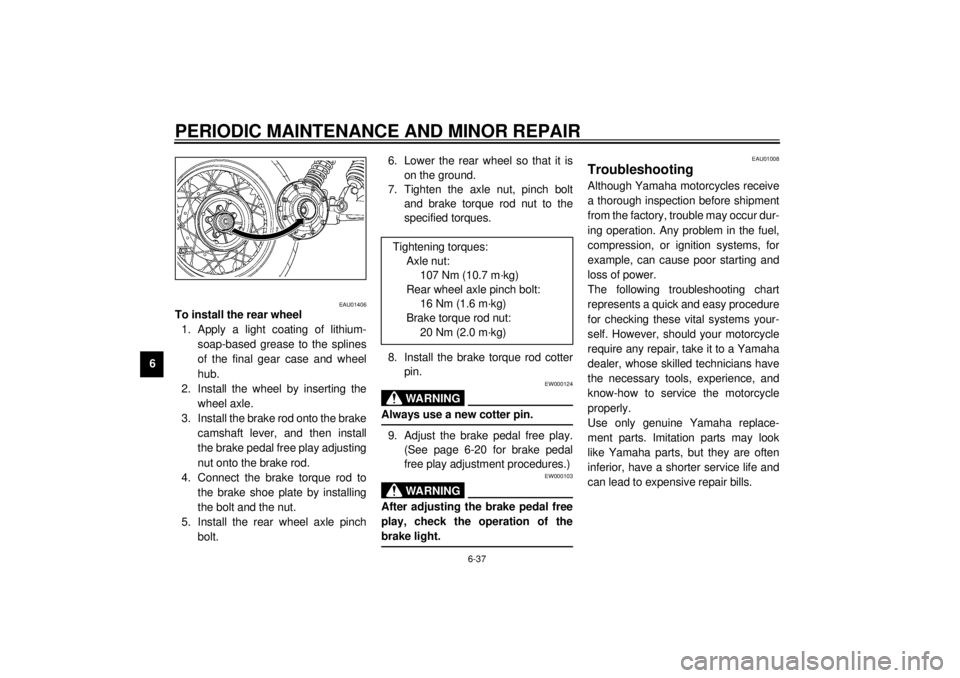
PERIODIC MAINTENANCE AND MINOR REPAIR
6-37
6
EAU01406
To install the rear wheel
1. Apply a light coating of lithium-
soap-based grease to the splines
of the final gear case and wheel
hub.
2. Install the wheel by inserting the
wheel axle.
3. Install the brake rod onto the brake
camshaft lever, and then install
the brake pedal free play adjusting
nut onto the brake rod.
4. Connect the brake torque rod to
the brake shoe plate by installing
the bolt and the nut.
5. Install the rear wheel axle pinch
bolt.6. Lower the rear wheel so that it is
on the ground.
7. Tighten the axle nut, pinch bolt
and brake torque rod nut to the
specified torques.
8. Install the brake torque rod cotter
pin.
EW000124
WARNING
_ Always use a new cotter pin. _9. Adjust the brake pedal free play.
(See page 6-20 for brake pedal
free play adjustment procedures.)
EW000103
WARNING
_ After adjusting the brake pedal free
play, check the operation of the
brake light. _
EAU01008
TroubleshootingAlthough Yamaha motorcycles receive
a thorough inspection before shipment
from the factory, trouble may occur dur-
ing operation. Any problem in the fuel,
compression, or ignition systems, for
example, can cause poor starting and
loss of power.
The following troubleshooting chart
represents a quick and easy procedure
for checking these vital systems your-
self. However, should your motorcycle
require any repair, take it to a Yamaha
dealer, whose skilled technicians have
the necessary tools, experience, and
know-how to service the motorcycle
properly.
Use only genuine Yamaha replace-
ment parts. Imitation parts may look
like Yamaha parts, but they are often
inferior, have a shorter service life and
can lead to expensive repair bills.
Tightening torques:
Axle nut:
107 Nm (10.7 m·kg)
Rear wheel axle pinch bolt:
16 Nm (1.6 m·kg)
Brake torque rod nut:
20 Nm (2.0 m·kg)
E_3bt.book Page 37 Thursday, September 7, 2000 10:01 AM
Page 75 of 96
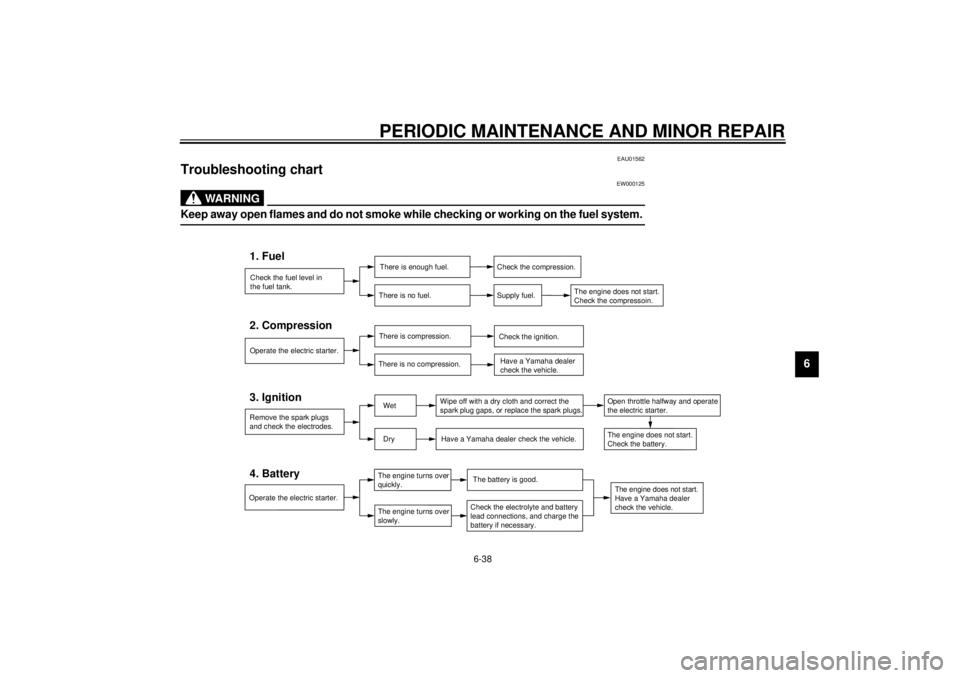
PERIODIC MAINTENANCE AND MINOR REPAIR
6-38
6
EAU01562
Troubleshooting chart
EW000125
WARNING
@ Keep away open flames and do not smoke while checking or working on the fuel system. @
Check the fuel level in
the fuel tank.1. Fuel
There is enough fuel.
There is no fuel.
Check the compression.
Supply fuel.
Operate the electric starter.2. Compression
There is compression.
There is no compression.
Check the ignition.
Have a Yamaha dealer
check the vehicle.
Remove the spark plugs
and check the electrodes.3. Ignition
Wet
Dry
Wipe off with a dry cloth and correct the
spark plug gaps, or replace the spark plugs.
Have a Yamaha dealer check the vehicle.
The engine does not start.
Check the battery.Open throttle halfway and operate
the electric starter.
Operate the electric starter.4. Battery
The engine turns over
quickly.
The engine turns over
slowly.The battery is good.
Check the electrolyte and battery
lead connections, and charge the
battery if necessary.The engine does not start.
Have a Yamaha dealer
check the vehicle.
The engine does not start.
Check the compressoin.
E_3bt.book Page 38 Thursday, September 7, 2000 10:01 AM
Page 76 of 96

E_3bt.book Page 39 Thursday, September 7, 2000 10:01 AM
Page 77 of 96
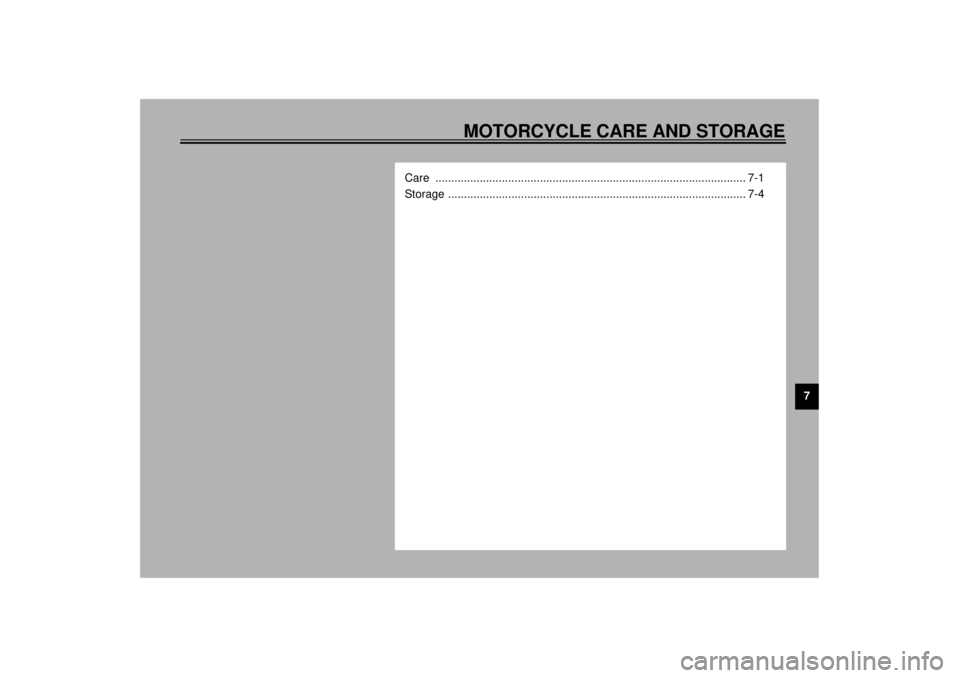
MOTORCYCLE CARE AND STORAGE
7
Care .................................................................................................. 7-1
Storage .............................................................................................. 7-4
E_3bt.book Page 1 Thursday, September 7, 2000 10:01 AM
Page 78 of 96
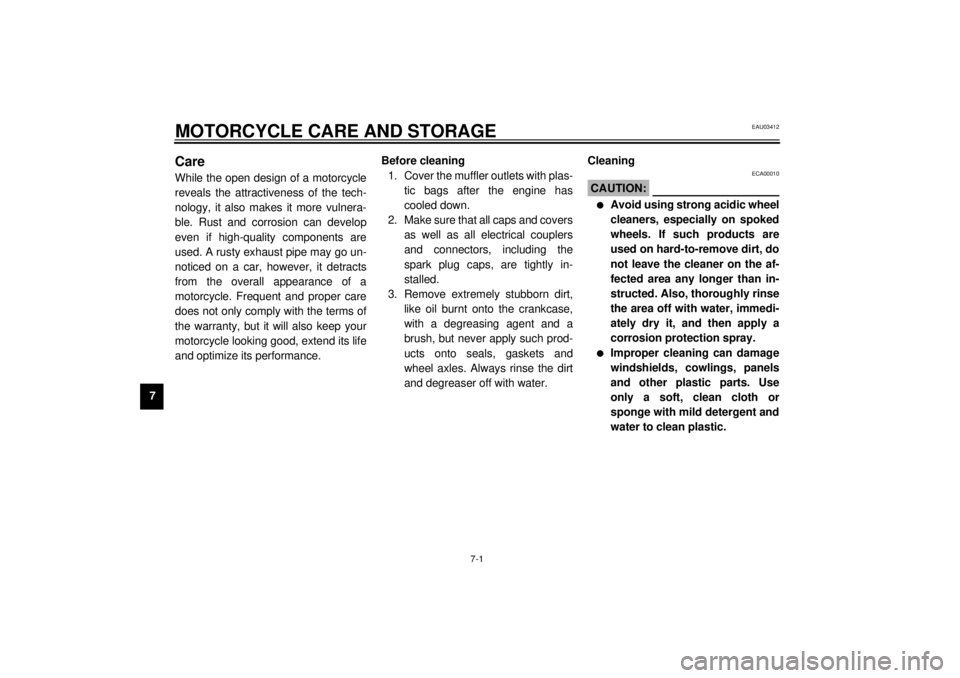
7-1
7
EAU03412
7-MOTORCYCLE CARE AND STORAGECare While the open design of a motorcycle
reveals the attractiveness of the tech-
nology, it also makes it more vulnera-
ble. Rust and corrosion can develop
even if high-quality components are
used. A rusty exhaust pipe may go un-
noticed on a car, however, it detracts
from the overall appearance of a
motorcycle. Frequent and proper care
does not only comply with the terms of
the warranty, but it will also keep your
motorcycle looking good, extend its life
and optimize its performance.Before cleaning
1. Cover the muffler outlets with plas-
tic bags after the engine has
cooled down.
2. Make sure that all caps and covers
as well as all electrical couplers
and connectors, including the
spark plug caps, are tightly in-
stalled.
3. Remove extremely stubborn dirt,
like oil burnt onto the crankcase,
with a degreasing agent and a
brush, but never apply such prod-
ucts onto seals, gaskets and
wheel axles. Always rinse the dirt
and degreaser off with water.Cleaning
ECA00010
CAUTION:@ l
Avoid using strong acidic wheel
cleaners, especially on spoked
wheels. If such products are
used on hard-to-remove dirt, do
not leave the cleaner on the af-
fected area any longer than in-
structed. Also, thoroughly rinse
the area off with water, immedi-
ately dry it, and then apply a
corrosion protection spray.
l
Improper cleaning can damage
windshields, cowlings, panels
and other plastic parts. Use
only a soft, clean cloth or
sponge with mild detergent and
water to clean plastic.
E_3bt.book Page 1 Thursday, September 7, 2000 10:01 AM
Page 79 of 96
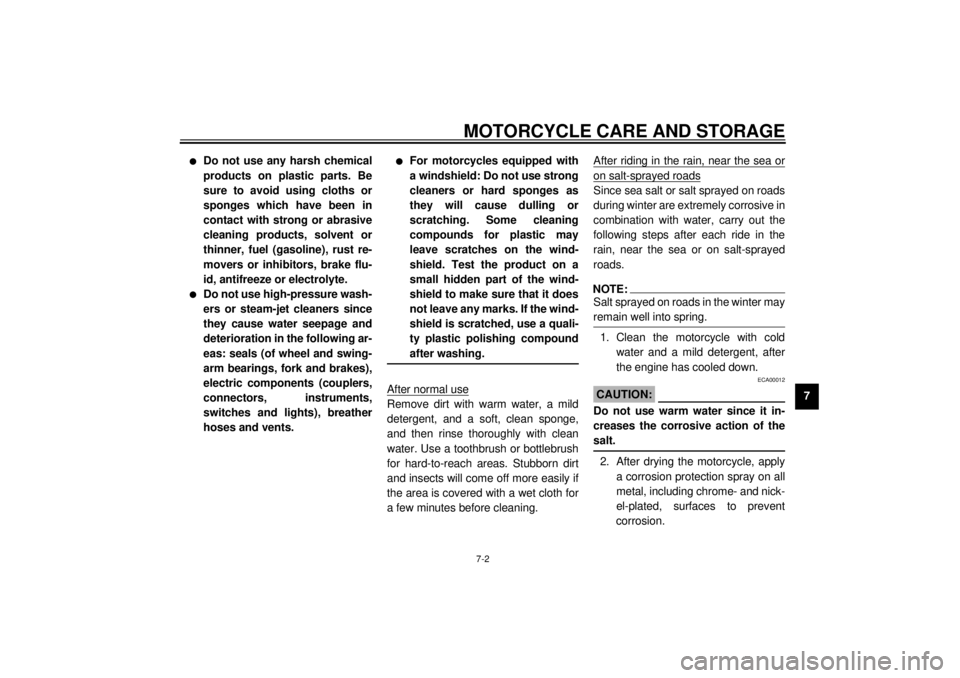
MOTORCYCLE CARE AND STORAGE
7-2
7
l
Do not use any harsh chemical
products on plastic parts. Be
sure to avoid using cloths or
sponges which have been in
contact with strong or abrasive
cleaning products, solvent or
thinner, fuel (gasoline), rust re-
movers or inhibitors, brake flu-
id, antifreeze or electrolyte.
l
Do not use high-pressure wash-
ers or steam-jet cleaners since
they cause water seepage and
deterioration in the following ar-
eas: seals (of wheel and swing-
arm bearings, fork and brakes),
electric components (couplers,
connectors, instruments,
switches and lights), breather
hoses and vents.
l
For motorcycles equipped with
a windshield: Do not use strong
cleaners or hard sponges as
they will cause dulling or
scratching. Some cleaning
compounds for plastic may
leave scratches on the wind-
shield. Test the product on a
small hidden part of the wind-
shield to make sure that it does
not leave any marks. If the wind-
shield is scratched, use a quali-
ty plastic polishing compound
after washing.
@After normal useRemove dirt with warm water, a mild
detergent, and a soft, clean sponge,
and then rinse thoroughly with clean
water. Use a toothbrush or bottlebrush
for hard-to-reach areas. Stubborn dirt
and insects will come off more easily if
the area is covered with a wet cloth for
a few minutes before cleaning.After riding in the rain, near the sea or
on salt-sprayed roadsSince sea salt or salt sprayed on roads
during winter are extremely corrosive in
combination with water, carry out the
following steps after each ride in the
rain, near the sea or on salt-sprayed
roads.NOTE:@ Salt sprayed on roads in the winter may
remain well into spring. @1. Clean the motorcycle with cold
water and a mild detergent, after
the engine has cooled down.
ECA00012
CAUTION:@ Do not use warm water since it in-
creases the corrosive action of the
salt. @2. After drying the motorcycle, apply
a corrosion protection spray on all
metal, including chrome- and nick-
el-plated, surfaces to prevent
corrosion.
E_3bt.book Page 2 Thursday, September 7, 2000 10:01 AM
Page 80 of 96
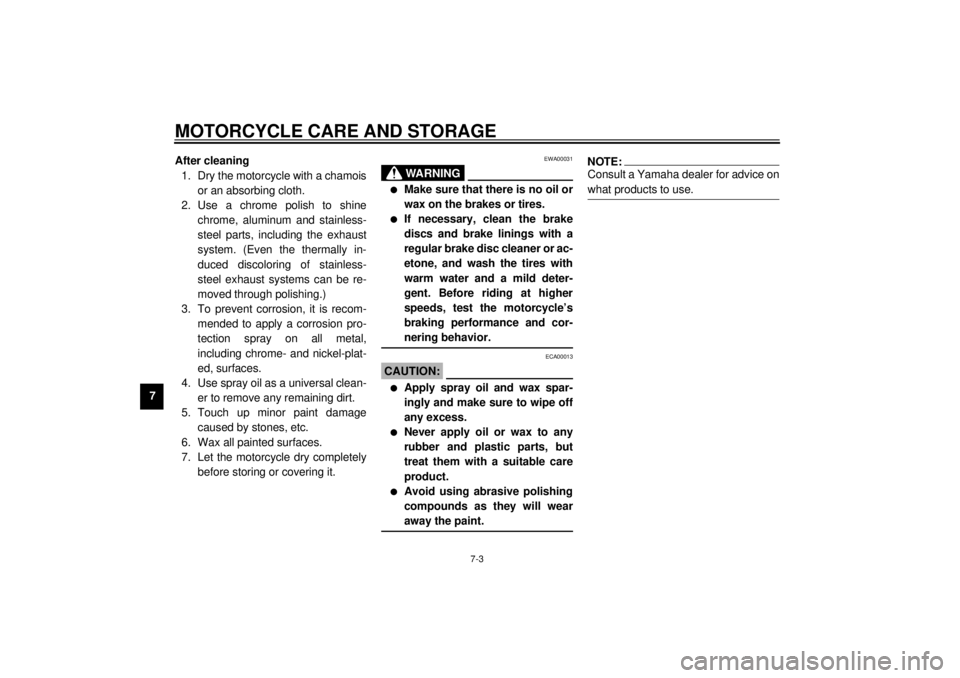
MOTORCYCLE CARE AND STORAGE
7-3
7After cleaning
1. Dry the motorcycle with a chamois
or an absorbing cloth.
2. Use a chrome polish to shine
chrome, aluminum and stainless-
steel parts, including the exhaust
system. (Even the thermally in-
duced discoloring of stainless-
steel exhaust systems can be re-
moved through polishing.)
3. To prevent corrosion, it is recom-
mended to apply a corrosion pro-
tection spray on all metal,
including chrome- and nickel-plat-
ed, surfaces.
4. Use spray oil as a universal clean-
er to remove any remaining dirt.
5. Touch up minor paint damage
caused by stones, etc.
6. Wax all painted surfaces.
7. Let the motorcycle dry completely
before storing or covering it.
EWA00031
WARNING
@ l
Make sure that there is no oil or
wax on the brakes or tires.
l
If necessary, clean the brake
discs and brake linings with a
regular brake disc cleaner or ac-
etone, and wash the tires with
warm water and a mild deter-
gent. Before riding at higher
speeds, test the motorcycle’s
braking performance and cor-
nering behavior.
@
ECA00013
CAUTION:@ l
Apply spray oil and wax spar-
ingly and make sure to wipe off
any excess.
l
Never apply oil or wax to any
rubber and plastic parts, but
treat them with a suitable care
product.
l
Avoid using abrasive polishing
compounds as they will wear
away the paint.
@
NOTE:@ Consult a Yamaha dealer for advice on
what products to use. @
E_3bt.book Page 3 Thursday, September 7, 2000 10:01 AM